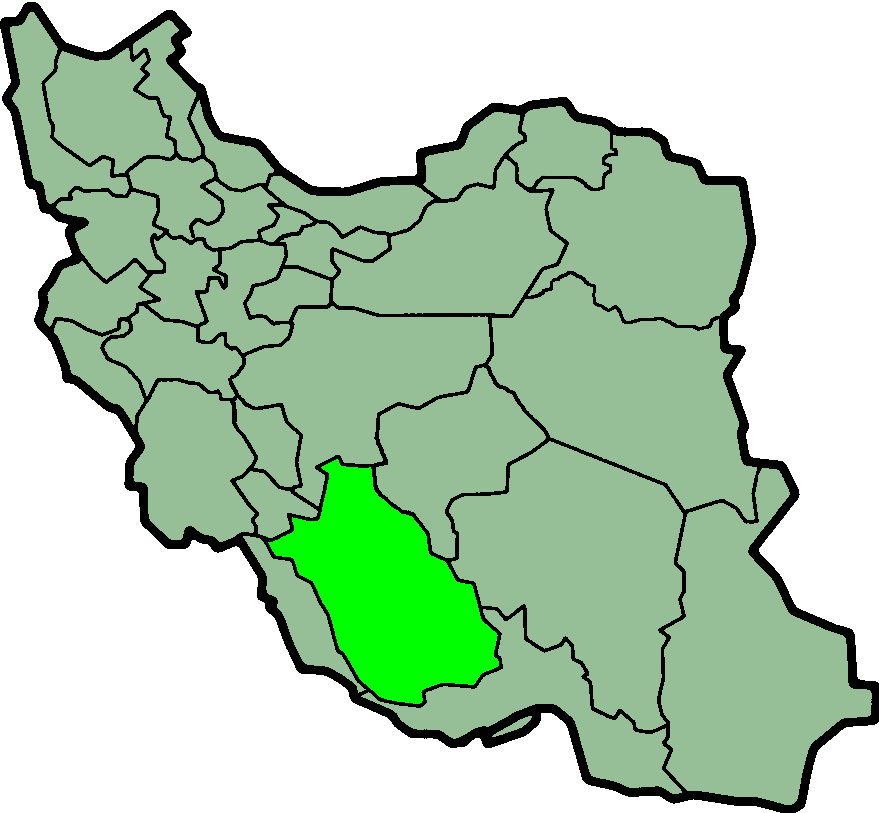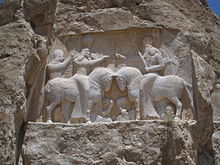This is an old revision of this page, as edited by Diyako (talk | contribs) at 01:40, 24 March 2006 (As per Britannica). The present address (URL) is a permanent link to this revision, which may differ significantly from the current revision.
Revision as of 01:40, 24 March 2006 by Diyako (talk | contribs) (As per Britannica)(diff) ← Previous revision | Latest revision (diff) | Newer revision → (diff) This article is about a geographical region. For language Fars, see Fars language.
Fars (Persian: فارس also called Farsistan) is one of the 30 provinces of Iran. It is in the south of the country and its center is Shiraz. It has an area of 122,400 sq. km. In 1996, this province had a population of 3.8 million people, out of which 42% resided in rural areas and the rest were urban settlers.
Nominally, Fars is the original homeland of the Persian people. The native name of the Persian language is Fārsi or Pārsi. Persia and Persian both derive from the Hellenized form Persis of the root word Pārs. Fārs is the Arabicised version of Pars. The Old Persian word was Pārsā.
Geography and climate

The Zagros Mountains stretch from the northwest to the southeast, dividing the province into two distinct geographical regions. The first is located on north-northwest, while the second is located on the south-southeast of the province, and both are mountainous highlands. According to the latest divisions, the province contains the following counties: Estahban, Abadeh, Eqleed, Bovanat, Jahrum, Darab, Sepidan, Shiraz, Fasa, Firouzabad, Kazeroon, Lar, Lamerd, Marvdasht, Mamasani, Khonj and Nayreez.
There are three distinct climatic regions in the Fars Province. First, the mountainous area of the north and northwest with moderate cold winters and mild summers. Secondly, the central regions, with relatively rainy mild winters, and hot dry summers. The third region located in the south and southeast, has moderate winters with very hot summers. The average temperature of Shiraz is 16.8° C, ranging between 4.7° and 29.2° C.
History and culture
Before Islam, two main Iranian leaders named Cyrus The Great and Ardeshir Babakan rose from Anshan and created the vast dynasties of the Achaemenids and Sassanids respectively. Alexander later established many cities in the province as well.

The cities of Fars province put up a firm resistence to the Arabs during the Islamic Conquest of Iran, particularly in areas around Istakhr. The province however, as well as all of Persia ultimately fell to the conquest.
Fars then passed hand to hand through numerous dynasties, leaving behind numerous historical and ancient monuments; each of which has its own values as a world heritage, reflecting the history of the province, Iran, and western Asia. The ruins of Bishapur, Persepolis, and Firouzabad are all reminders of this.
Thus due to the geographical characteristics of Fars and its proximity to the Persian Gulf, Fars has long been a residing area for different natives and tribes from other parts of the world such as the Turks, Semites, and Aryans who were under the influence of Iranian culture. However, the original tribes of Fars including Qashqai, Mamasani, Khamseh and Kohkiluyeh have kept their native and unique cultures and lifestyles which constitute part of the cultural heritage of Iran attracting many tourists.
Fars today

Shiraz Airport is the main international airport of the province. The cities of Lar and Lamerd also have airports linking them with Shiraz and Tehran and nearby Persian Gulf countries such as the UAE and Bahrain. Shiraz is along the main route from Tehran to southern Iran.
Agriculture is of great importance in Fars. The major products include cereal (wheat and barley), citrus fruits, dates, sugar beets and cotton.
Fars has major petrochemical facilities, along with an oil refinery, a factory for producing tires, a large electronics industry, and a sugar mill.
Tourism is also a large industry in the province. Many come to see the superb handicrafts such as the silver smithing, marquette and skill-embroidery of Shiraz; the Giveh weaving of Abadeh; the ceramics in Estahban ; and the rug, jajim (fine carpet made of wool or cotton), and Gelim (carpet made of goats' hair) of Firouzabad. The tribal woven rugs, the rose water made in Firouzabad, the sweets produced in Fasa, and the lime juice and plant essence extracted in Shiraz are of the highest quality.
Shiraz is also where a famous Persian ice cream named faloodeh is made as well.
UNESCO has designated an area in the province, called Arjan (known as Dasht e Arjan) as a biosphere reserve.
Attractions of Fars
| This list is incomplete; you can help by adding missing items. |
Fars as homeland of Achaemenid and Sassanid Persians, hosts numerous splendid archaeological site, monuments, mosques and gardens.

Pre-Islamic sites
- Pasargadae
- Persepolis
- Palace of Apadana
- Ancient city of Bishapur
- Ancient city of Firouzabad
- Naqsh-e Rostam
- Ghal'eh Dokhtar,
- Palace of Ardashir, The Palace ruins of Sassanid king Ardashir I
Post-Islamic
See Shiraz
Colleges and universities

Fars province contains the following major universities:
- Shiraz University of Medical Sciences
- Shiraz University
- Shiraz University of Technology
- Islamic Azad University of Abadeh
- Islamic Azad University of Arsanjan
- Islamic Azad University of Estahban
- Islamic Azad University of Eghlid
- Islamic Azad University of Jahrom
- Islamic Azad University of Sepidan
- Islamic Azad University of Shiraz
- Islamic Azad University of Fasa
- Islamic Azad University of Firouzabad
- Islamic Azad University of Kazerun
- Islamic Azad University of Larestan
- Islamic Azad University of Marvdasht
- Fasa University of Medical Sciences
- Jahrom University of Medical Sciences
- Shiraz University of Applied Science and Technology
Notables from Fars
- Christiane Amanpour's father is originally from Sarvestan, Fars.
- Sibawayh, one of the founders of Arabic grammar, died in Shiraz.
- Karim Khan, founder of the Zand dynasty.
- Lotf Ali Khan, the last ruler of the Zand dynasty.
- Saadi, writer, poet, born and died in Shiraz.
- Hafez, poet, born and died in Shiraz.
- Zahra Kazemi, photographer, born in Shiraz.
- Ladan and Laleh Bijani, famous conjoined twins, born in Shiraz.
- Shāh Shoja', buried in Shiraz.
- Khwaju Kermani, buried in Shiraz.
- Mulla Sadra was born in Shiraz.
- Asghar Shekari was born in Shiraz.
- Seyyed Zia'eddin Tabatabaee was born in Shiraz.
- Ibn Khafif, a 9th century sage, is buried in Shiraz.
- Sheikh Ruzbehan
- Meulana Shahin Shirazi
- Junayd Shirazi
- Mohsen Kadivar
- Ata'ollah Mohajerani was a representative of Shiraz in the Majlis.
- Saeed Emami
- Gholamhossein Azhari
- Siyyid Mírzá 'Alí-Muhammad, The Báb
Fars Province in poetry
| Fars: The ancient homeland of Persia. | |
|---|---|
|
روی گفتم که در جهان بنهم که نه بیرون پارس منزل هست "I said, turn your path to the greater world, But I found no place for me outside of Fars, --Hafez, The Nightingale of Shiraz | |
External links
- Official website of Fars Governorship
- Cultural Heritage Foundation of Fars Province
- Official website of Persepolis
- Fars Chamber of Commerce
- Fars Regional Library of Science and Technology
- Fars Blood Transfusion Organization (in Persian)
- Fars Province Department of Planing and Management
- Fars Province Department of Education (in Persian)
- Fars Province Department of Labour (in Persian)
- Kazeroon Mayor's Office
- Larestan Mayor's Office
- Shiraz Chamber of Commerce
- UNESCO Biosphere Reserve of Arjan